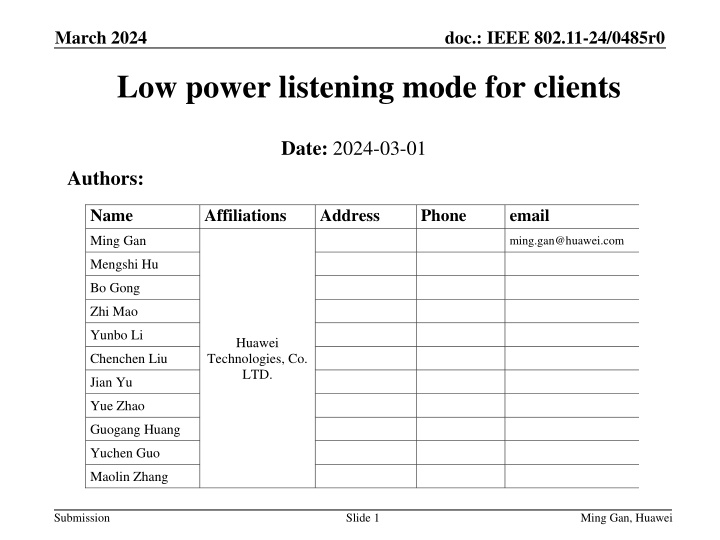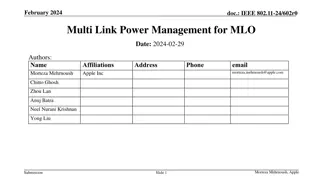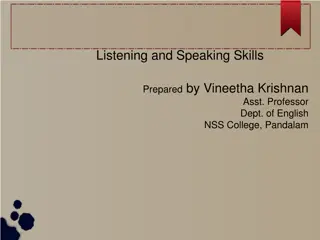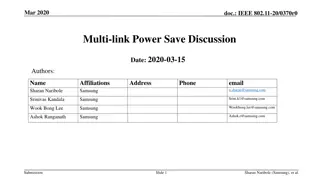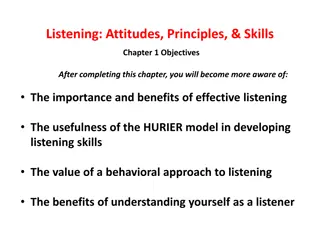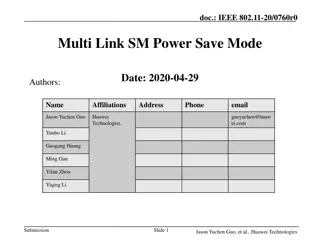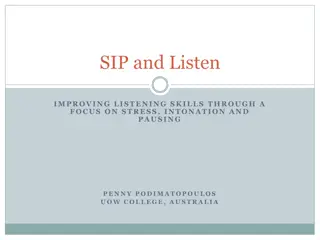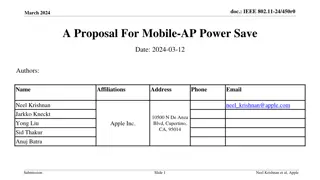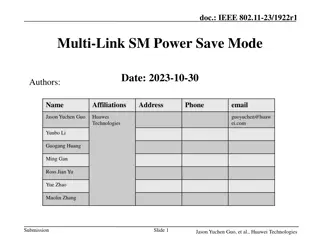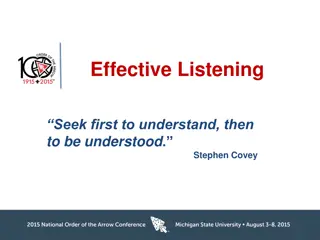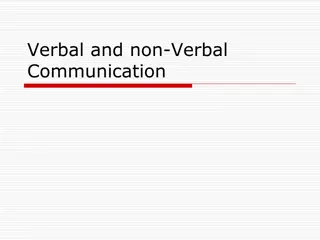Low power listening mode for clients
This document explores the implementation of a low power listening mode for clients in IEEE 802.11-24 networks. The mode aims to reduce power consumption significantly by introducing a 20MHz low power listening chain. Various aspects such as power consumption reduction, introduction of initial control frames, and data transmission efficiency are covered.
Download Presentation

Please find below an Image/Link to download the presentation.
The content on the website is provided AS IS for your information and personal use only. It may not be sold, licensed, or shared on other websites without obtaining consent from the author.If you encounter any issues during the download, it is possible that the publisher has removed the file from their server.
You are allowed to download the files provided on this website for personal or commercial use, subject to the condition that they are used lawfully. All files are the property of their respective owners.
The content on the website is provided AS IS for your information and personal use only. It may not be sold, licensed, or shared on other websites without obtaining consent from the author.
E N D
Presentation Transcript
March 2024 doc.: IEEE 802.11-24/0485r0 Low power listening mode for clients Date: 2024-03-01 Authors: Name Affiliations Address Phone email Ming Gan ming.gan@huawei.com Mengshi Hu Bo Gong Zhi Mao Yunbo Li Huawei Chenchen Liu Technologies, Co. LTD. Jian Yu Yue Zhao Guogang Huang Yuchen Guo Maolin Zhang Submission Slide 1 Ming Gan, Huawei
March 2024 doc.: IEEE 802.11-24/0485r0 Background Low power listen mode was proposed by [1], and this concept have gradually received much support. Listening mode contributes more than half of the power consumption in testing Introducing a 20MHz LPL chain can brings the power consumption down to certain level, such as 10%-20% relative to the regular power consumptions in RF MU-RTS PPDU CTS BA Low power listening mode 1 ss, 20 MHz, low MCS Regular TX/RX mode Up to 8 ss, 320 MHz, 4K QAM Low power listening mode 1 ss, 20 MHz, low MCS Submission Slide 2 Ming Gan, Huawei
March 2024 doc.: IEEE 802.11-24/0485r0 Background Reference [2] and [3] continue to develop this low power listen mode and provide more details Extra FCS with padding for transition delay between the low power listen mode and the regular TX/RX mode The low power listen mode is at link level Mandate inclusion of initial control frame (ICF) at the beginning of the TXOP In this contribution, we will provide our thought about this feature from the following aspects TXOP Sequence in regular TX/RX mode Extra FCS design Submission Slide 3 Ming Gan, Huawei
March 2024 doc.: IEEE 802.11-24/0485r0 TXOP Sequence in regular TX/RX mode According to reference [4], more than 60% DL packets and almost 90% UL packets are less 100 bytes in enterprise scenarios. Similar tendency can also be seen in other scenarios For packets of small size, it doesn t require more spatial streams, large bandwidth and high MCS. We propose 20 MHz Data transmission in low power listening mode 20 MHz Data transmission is in non-HT PPDU format with 1 spatial stream and low MCS Mandate inclusion of initial control frame (ICF) at the beginning of the TXOP for transmission with more than 20 MHz bandwidth Much overheads, especially for large transition delay, are saved 20 MHz non- HT PPDU MU-RTS PPDU Ack BA CTS Low power listening mode 1 ss, 20 MHz, low MCS Regular TX/RX mode Up to 8 ss, 320 MHz, 4K QAM Low power listening mode 1 ss, 20 MHz, low MCS Submission Slide 4 Ming Gan, Huawei
March 2024 doc.: IEEE 802.11-24/0485r0 TXOP Sequence in regular TX/RX mode MU-RTS frame should be transmitted in non-HT duplicated format and its bandwidth may be larger than 20 MHz. At the client side, it only receives 20 MHz MU-RTS since it is in low power listening mode. However, the response frame may also be larger than 20MHz, depending on the implementation and CCA results Padding added in MU-RTS provides enough transition delay for client For the TXOP Sequence, the following rule should be obeyed The PPDU bandwidth should be narrower or equal to its preceding PPDU bandwidth in the same TXOP Rules are defined in EMLSR/EMLMR for switching back to the listening operation can also be reused for this TXOP Sequence termination in regular TX/RX mode We are also open to other methods for termination Submission Slide 5 Ming Gan, Huawei
March 2024 doc.: IEEE 802.11-24/0485r0 Extra FCS design Extra FCS design involve the following aspects The size of extra FCS The container of extra FCS The location identification of extra FCS For the size of FCS, we prefer to keep the same size as current FCS, which is 4 bytes Keep the same size to avoid the asymmetry issue on false alarm and missing rate with respect to legacy devices On the other hand, there are other two candidates from the aspect of reusing current 802.11 CRC engines 16-bit CRC (e.g., SIG field protection of DSS PHY (15.3.3.7 (PHY CRC field), which is used to validate 32 bits PHY signaling 8-bit CRC (e.g., A-MPDU delimiter protection (9.7.2 (MPDU delimiter CRC field), which obviously, which is used to validate 16 bits in MPDU delimiter. Submission Slide 6 Ming Gan, Huawei
March 2024 doc.: IEEE 802.11-24/0485r0 Extra FCS design To keep the same structure of the trigger frame, we also prefer to have User Info field to include extra FCS as in [3], but the number of User Info field is only one The Use Info field that includes extra FCS doesn t starts a special AID, but extra FCS. The remaining bits in this User Info field are reserved. Compared to special AID for identifying the location of extra FCS, we propose an earlier indication for it Simplify parsing action at the client side and also help quickly identify the location of extra FCS Frame Control User Info 2 Common Info Special User Info User Info 1 Padding User Info TA Duration RA Extra FCS FCS Example for initial control frame Submission Slide 7 Ming Gan, Huawei
March 2024 doc.: IEEE 802.11-24/0485r0 Extra FCS design An earlier indication for identifying the location of extra FCS For example, reuse UL Length field which is reserved in MU-RTS Regarding padding between extra FCS and FCS, it should also start with AID of 4095. Submission Slide 8 Ming Gan, Huawei
March 2024 doc.: IEEE 802.11-24/0485r0 Summary In this contribution, we propose the following aspects for low power listening mode at the clients side. 20 MHz non-HT PPDU should be transmitted in low lower listening mode, not regular TX/RX mode An earlier indication in Common User info field for location identification of extra FCS of 4 bytes The Use Info field that includes extra FCS doesn t starts with a special AID, but extra FCS. The remaining bits in this User Info field are reserved. Submission Slide 9 Ming Gan, Huawei
March 2024 doc.: IEEE 802.11-24/0485r0 References [1] 11-22-1414-01-0uhr-low-power-listening-mode [2] 11-23-1875-01-00bn-power-save-proposal-for-non- ap-mobile-ap [3] 11-23-2003-01-00bn-client-power-save [4] 11-14-0874-00-00ax-unified-traffic-model-on- enterprise-scenario Submission Slide 10 Ming Gan, Huawei
